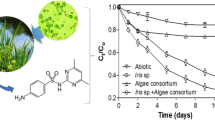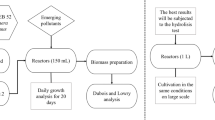Abstract
Objective
To test the toxicity of ketoprofen (a commonly-used NSAIDs) using two microalgal strains and Artemia sp. following the isolation of bacterial and microalgal strains and testing their ability to biodegrade and tolerate ketoprofen.
Results
Chlorella sp. was the most resistant to ketoprofen. A defined bacterial consortium (K2) degraded 5 mM ketoprofen as a sole carbon source both in the dark or continuous illumination. Ketoprofen did not undergo photodegradation. In the dark, biodegradation was faster with a lag phase of 10 h, 41% COD removal and 82 % reduction in toxicity. The consortium degraded up to 16 mM ketoprofen. The consortium was composed of four bacterial isolates that were identified. MS/MS analysis suggested a ketoprofen biodegradation pathway that has not been previously reported. Combining Chlorella sp. and the K2 consortium, ketoprofen was degraded within 7 days under a diurnal cycle of 12 h light/12 h dark.
Conclusion
The feasibility of using a microalgal–bacterial system to treat pharmaceutical wastewater is promising for the reduction of the process cost and providing a safer technology for pharmaceutical wastewater treatment.





Similar content being viewed by others
References
Durbize E, Vigan M, Puzenat E et al (2003) Spectrum of cross-photosensitization in 18 consecutive patients with contact photoallergy to ketoprofen: associated photoallergies to non-benzophenone-containing molecules. Contact Dermat 48:144–149
Essam T, Amin MA, El Tayeb O et al (2010) Kinetics and metabolic versatility of highly tolerant phenol degrading Alcaligenes strain TW1. J Hazard Mater 173:783–788
Essam T, Rakaiby MEL, Agha A (2014) Remediation of the effect of adding cyanides on an algal/bacterial treatment of a mixture of organic pollutants in a continuous photobioreactor. Biotechnol Lett 36:1773–1781
Kester DR, Duedall IW, Connors DN et al (1967) Preparation of artificial seawater. Limnol Oceanogr 12:176–179
Kim BH, Ramanan R, Cho DH et al (2012) Simple, rapid and cost effective method for high quality nucleic acids extraction from different strains of Botryococcus braunii. PLoS One 7:e37770
Kloepfer A, Gnirss R, Jekel M et al (2004) Occurrence of benzothiazoles in municipal wastewater and their fate in biological treatment. Water Sci Technol 50:203–208
Marco-Urrea E, Perez-Trujillo M, Cruz-Morato C et al (2010) White rot fungus-mediated degradation of the analgesic ketoprofen and identification of intermediates by HPLC-DAD-MS and NMR. Chemosphere 78:474–481
Peng Ze WuF, Deng N (2006) Photodegradation of bisphenol A in simulated lake water containing algae, humic acid and ferric ions. Environ Pollut 144:840–846
Persoone G (1986) Ecotoxicological testing for the marine environment. Springer, Berlin
Quintana JB, Weiss S, Reemtsma T (2005) Pathways and metabolites of microbial degradation of selected acidic pharmaceutical and their occurrence in municipal wastewater treated by a membrane bioreactor. Water Res 39:2654–2664
Rakaiby MEL, Essam T, Hashem A (2012) Isolation and characterization of relevant algal and bacterial strains from Egyptian environment for potential use in photosynthetically aerated wastewater treatment. J Bioremed Biodegrad S8:001
Tamer E, Amin MA, El Tayeb O et al (2006) Biological treatment of industrial wastes in a photobioreactor. Water Sci Technol 53:117–125
Tastan BE, Duygu E, Donmez G (2012) Boron bioremoval by a newly isolated Chlorella sp. and its stimulation by growth stimulators. Water Res 46:167–175
Verlicchi P, Al Aukidy M, Zambello E (2012) Occurrence of pharmaceutical compounds in urban wastewater: Removal, mass load and environmental risk after a secondary treatment-a review. Sci Total Environ 429:123–155
Wojcieszyńska D, Domaradzka D, Hupert-Kocurek K et al (2014) Bacterial degradation of naproxen-Undisclosed pollutant in the environment. J Environ Manage 145:157–161
Ziylan A, Ince NH (2011) The occurrence and fate of anti-inflammatory and analgesic pharmaceuticals in sewage and fresh water: treatability by conventional and non-conventional processes. J Hazard Mater 187:24–36
Acknowledgments
We are thankful to Dr Aliaa Kamal, associate professor of the Pharmaceutical Organic Chemistry Department, Faculty of Pharmacy, Cairo University, for her help with interpretation of the MS/MS analysis results.
Author information
Authors and Affiliations
Corresponding author
Rights and permissions
About this article
Cite this article
Ismail, M.M., Essam, T.M., Ragab, Y.M. et al. Biodegradation of ketoprofen using a microalgal–bacterial consortium. Biotechnol Lett 38, 1493–1502 (2016). https://doi.org/10.1007/s10529-016-2145-9
Received:
Accepted:
Published:
Issue Date:
DOI: https://doi.org/10.1007/s10529-016-2145-9




